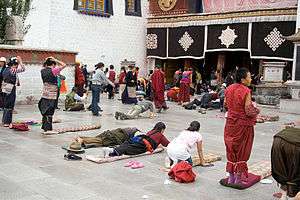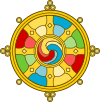Monlam Prayer Festival
Monlam also known as The Great Prayer Festival, falls on 4th–11th day of the 1st Tibetan month in Tibetan Buddhism.
| Monlam Prayer Festival | |||||||
|---|---|---|---|---|---|---|---|
 Pilgrims at Jokhang, Lhasa during Monlam | |||||||
| Chinese name | |||||||
| Simplified Chinese | 默朗木祈愿大法会 | ||||||
| Traditional Chinese | 孟蘭祈願大法會 | ||||||
| |||||||
| Alternative Chinese name | |||||||
| Simplified Chinese | 传召法会 | ||||||
| Traditional Chinese | 傳召法會 | ||||||
| |||||||
| Tibetan name | |||||||
| Tibetan | སྨོན་ལམ་ | ||||||
| |||||||
| Part of a series on |
| Tibetan Buddhism |
|---|
 |
|
|
|
Practices and attainment |
|
Institutional roles |
|
History and overview |
History
The event of Monlam in Tibet was established in 1409 by Tsong Khapa, the founder of the Geluk tradition. As the greatest religious festival in Tibet, thousands of monks (of the three main monasteries of Drepung, Sera and Ganden) gathered for chanting prayers and performing religious rituals at the Jokhang Temple in Lhasa.
In 1517, Gedun Gyatso became the abbot of Drepung monastery and in the following year, he revived the Monlam Chenmo, the Great Prayer Festival and presided over the events with monks from Sera, Drepung and Gaden, the three great monastic Universities of the Gelugpa Sect.[1]
"The main purpose of the Great Prayer Festival is to pray for the long life of all the holy Gurus of all traditions, for the survival and spreading of the Dharma in the minds of all sentient beings, and for world peace. The communal prayers, offered with strong faith and devotion, help to overcome obstacles to peace and generate conducive conditions for everyone to live in harmony."[2]
The celebration of Monlam in the Lhasa Jokhang was forbidden during the Cultural Revolution (1966–1976),[3] although it had not been practiced there since 1959, and would not be hosted in Lhasa again until 1986.[4] During the late 1980s, Tibetan organizers used Monlam and post-Monlam ceremonies for political demonstrations. During Monlam, monks stood on platforms to pray for the long life of the 14th Dalai Lama, boys threw rocks at observing police, and symbols advocating Tibetan independence displayed. When these demonstrations failed to produce results, monks even suggested boycotting Monlam to show their displeasure with the government.[5] Since security forces were prohibited from breaking up the demonstrations as "they were ostensibly [purely] religious", the city government suspended the Monlam in 1990.[6]
Monlam festivals are upheld by Tibetan Buddhist monasteries established in exile in India.
Practices
Examinations for the highest 'Lharampa Geshe' degree (a degree in Buddhist philosophy in the Geluk tradition) were held during the week-long festival. Monks would perform traditional Tibetan Buddhist dances (cham) and huge ritual offering cakes (tormas) were made, that were adorned with very elaborate butter sculptures. On the fifteenth day the highlight of Monlam Chenmo in Lhasa would be the "Butter Lamp Festival" (Chunga Chopa), during which the Dalai Lama would come to the Jokhang Temple and perform the great Buddhist service. Barkhor Square in front of the Jokhang would be turned into a grand exhibition site for the huge tormas. At the end of the festival, these tormas would be burned in a large bon-fire.
Traditionally, from New Year's Day until the end of 'Monlam', lay Tibetans would make merry. Many pilgrims from all over Tibet would join the prayers and teachings, and make donations to the monks and nuns.
Many other monasteries would hold special prayer sessions and perform religious rituals, for example some monasteries would unfold huge religious scroll-paintings (thangkas) for all to see.
Aspiration Prayers
In the Kagyu Monlam Chenmo, the main practice by the assembled monks and lay people is the Wishing Prayer of Samantabhadra,[7] part of the preserved words of the Buddha according to the Tibetan tradition. This prayer has at its core the Enlightened Attitude (Bodhisattva Vow) of Mahayana Buddhism, that the practitioner may attain enlightenment for the benefit of all beings.
See also
References
- "The Dalai Lamas". His Holiness the 14th Dalai Lama of Tibet. The Office of His Holiness the Dalai Lama. Archived from the original on 2012-10-16. Retrieved 2015-02-16.
- Staff (2004–2005). "Monlam Chenmo in Kopan (20-24 Feb. 2005)" (PDF). Kopan Monastery. Retrieved 2010-02-04.
- Greenfield, Jeanette (2007). The Return of Cultural Treasures. Cambridge University Press. p. 358.
- Sautman, Barry; Dreyer, June (2006). Contemporary Tibet: Politics, Development, and Society in a Disputed Region. M.E. Sharpe. p. 37.
- Schwartz, Ronald (1994). "A Battle of Ideas". Circle of Protest: Political Ritual in the Tibetan Uprising. Columbia University Press. pp. 107–111.
- Barnett, Robert; Akiner, Shirin (1994). Resistance and Reform in Tibet. Hurst. p. 249.
- "Kagyu Monlam: The Path of Aspiration". 2014. Retrieved 2014-12-03.
External links
- Brief Ritual Sadana Vow of Kriya Yoga
- Kagyu Monlam Chenmo (Orgyen Trinley)
- Kagyu Monlam Chenmo (Thaye Dorje)
- Nyingma Monlam Chenmo
.